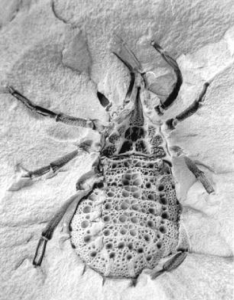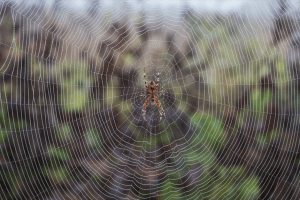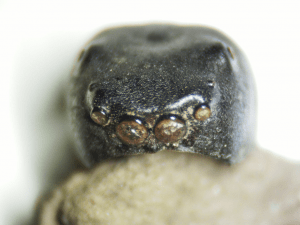Guest Author: Dr Rachel Kruft Welton
Current Palaeobiology MSc Student, University of Bristol
The story of spider evolution starts over 400Ma, when their eight-legged, thick-waisted ancestor crawled out onto land. The pre-cursor to spiders were chunky beasts called trigonotarbids. The earliest trigonotarbid fossil comes from Silurian rocks near Ludlow, Shropshire. Trigonotarbids were a successful group of arthropods, whose fossil record stretches from the Silurian, through to the Permian. Unlike spiders, they had a segmented abdomen (opisthosoma), which can be seen in the 3D fossil (Figure 1), and no spinnerets, suggesting that they did not make silk, or at least not strands of it.

Silk is definitely not a substance that functions well underwater, so it is unlikely to have evolved before the animals became fully terrestrial. Exceptionally preserved specimens of the Rhynie chert near Aberdeen, Scotland, show that they had fully terrestrial book-lungs, even in the Devonian. There is also no evidence of venom, although they had biting fangs, which bit down vertically into their prey. They had several sets of eyes, both on top of the head and off to the sides, paving the way for the 6-8 eyes of modern spiders.
The first proto-spider, still lacking spinnerets, comes from the mid-Devonian, Gilboa fossils of New York, 380Ma. Attercopus fimbriuguis (Attercopus literally meaning poison-head) had a whip-tail, similar to scorpions, and openings on the underside of its abdomen, which have been interpreted as silk glands. There is some debate about the early use of silk. It was probably originally used as a proteinaceous secretion that prevented things drying out. Silk may have been wrapped around the eggs to prevent desiccation and to discourage predators. It may also have been used to protect early gills from drying out, before the evolution of book-lungs. It could even have been used as a protection from the harsh UV rays of the sun, as the ozone layer was still very thin in the Palaeozoic era. Silk is very good at reflecting UV light. At first, silk may just have been wrapped around the abdomen, but later it was woven into a canopy or sheet web for the spider to shelter under. Attercopus could have used silk to line a burrow, but not to spin webs.
By the Upper Carboniferous, fossils found in France show spiders with spinnerets, and fangs that strike vertically. Vertical chelicerae are considered the ancestral condition, and they are still found in Mygalomorphae spiders, such as tarantulas and trap-door spiders. The Australian funnel web spider belongs to this group. Funnel web spiders have elongated spinnerets, and spiders with such spinnerets were present by the Permian. Of course, behaviour doesn’t fossilise, but the morphology found in a Permian specimen suggests that funnel web building, with or without trip-lines, was certainly likely 270Ma.
The end-Permian extinction was followed by an adaptive radiation of spiders in the Triassic. The first web building spiders appeared around 200Ma. Spiders with rotated chelicerae appeared, allowing the spider to bite horizontally in a pincer movement. These types of spider make up around 80% of the 45,000 modern species. Orb webs (Figure 2) seem to have been one of the earliest types of web to evolve, although this seems counterintuitive, given their apparent complexity. There are, however, good reasons for thinking this.

Around the start of the Jurassic, the nature of web-building divides into two different methods of capturing prey. Some spiders furnish their webs with sticky glue whereas others use an organ called a cribellum to rough up the silk. These are known as the ecribellate and cribellate spiders respectively. The cribellum uses many fine strands to make the silk knotty, like back-combed hair or Velcro, which ensnares prey by tangling them. Cribellate spiders can be identified by the cribellum in the abdomen, which is rather small, or by a row of toothed bristles on their back legs. Both types of spider, however, build orb webs, and it is thought that such a complex behaviour could only evolve once. This is one of the reasons why orb-weaving is thought to be the ancestral state in spider evolution.
Orb weaving has been modified or lost in many different ways. Spiders are universally carnivorous and have found a wide variety of methods of catching prey. The majority of spiders are insectivores, and they have provided a heavy selection pressure on insect evolution. The radiation of insect forms started 100Ma before the first flowering plants, due to predation pressure from spiders. In the Devonian, when there were no flying insects, spiders were ground-living species with burrows and trip-wires. Flying insects had arrived by the Carboniferous and spiders were placing webs higher. As insects evolved stronger wings and took to the skies, spiders moved their webs higher, up into the bushes and trees. The arms-race between them was fully underway.
In the evolutionary arms-race between insects and spiders, butterflies and moths evolved scales capable of flaking off when caught in a web. Orb—weavers countered, by developing a ladder-like web. When the moth flies into the web, it tumbles free by losing a few scales. The ladder structure keeps the moth tumbling until there are no more scales to flake off and the insect becomes trapped.
By the Cretaceous most modern families of spiders were already around. Spiders found in amber sometimes contain traces of web with them, and allow an insight into the evolution of behaviour. Linyphiidae (money spiders) build dome or bowl-shaped webs; Theridiidae throw nets of silk over their prey; the awesome bolas spider swings a line of silk with a sticky blob on the end to capture its prey. Still others have webs that collapse around prey or have loose threads that swing prey into the centre of a silken net.

Some spiders have secondarily lost web-building behaviour altogether, and behave as ambush predators or hunters instead. Wolf spiders (Lycosidae) patrol the leaf litter, hunting their prey. My favourite, though, are the jumping spiders (Salticidae) who ambush prey by leaping at them. Both wolf and jumping spiders need excellent eyesight to stalk their prey. The jumping spider (Figure 3) has binocular vision, with the central median eyes looking like a pair of headlamps. The spider pictured was found in Californian tar-pits dating back to the last ice-age (40,000 years ago). The large, front-facing eyes clearly show that this spider was capable of judging distance when hunting.
Spiders have been around for at least 380Ma, radiating into many different forms, and driving the evolution of their prey. With venom and silk, spiders have successfully navigated mass extinctions and ice-ages, surviving in every habitat from freshwater to deserts. The fossil record may be scant, but such small peeks as we have into the past allow extrapolation to piece together developments in the behaviour of these delightful eight-legged beasties.
References:
Rahman, I, et al. (2012) Virtual Fossils: a New Resource for Science Communication in Paleontology. Evolution: Education and Outreach 5 DOI: 10.1007/s12052-012-0458-2
Vollrath, F & Selden, P (2007) The Role of Behaviour in the Evolution of Spiders, Silks and Webs. Annual Review of Ecology, Evolution and Systematics. 38:819-846
Wessel, L, (2018) Sticky science: Evolution of Spiderwebs. Knowable Magazine. Online: www.knowablemagazine.org. Accessed 12/03/2019
Edited by Rhys Charles

